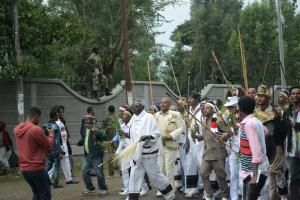After assessing the situation of the country, the Council of Minister of Ethiopia decided today to lift the six month state of emergency declared in mid-February.
After the decision will be approved by the national parliament of the country on Monday, the command post, which has been in charge of implementing the Martial Law will end its duties. The government was forced to introduce the state of emergency following the anti-government protests.
The decision to lift the state of emergency was said because peace is being restored in the country. The Council of Ministers has sent the decision to national parliament which is expected to approve in the coming days.
Ethiopia was forced to declare the state of emergency twice over the past few years, as a result of the protests of youth mainly in Oromia and Amhara regions of the country.
The Oromia youth protests began mainly following 100% national election winning by the ruling party Ethiopian Peoples’ Revolutionary Democratic Front (EPRDF) in May 2015.
The youth in Oromia have also opposed the regime for allowing the expansion of the Addis Ababa City Administration into the neighboring Oromia Region, which forced the farmers to leave their farmlands.
The youth have also been claiming that they have been exposed for unemployment, injustice and unfair distribution of wealth, among other things. In recent months the youth have also been clashing with the military in some parts of the country claiming that some corrupt military personnel have been engaged in contraband trades such as sugar smuggling and the like.
In solidarity with the Oromo youth and demanding for democracy and opposing injustice, the youth in Amhara Region, mainly around Gondar area have also joined the protest.
They have also opposed the arrest of individuals who were against the inclusion of some parts of Amhara Region into Tigray Region, among others. Finally the anti-government protest has expanded into different parts of the country. As a result many people have died and wounded by the measures taken by the security forces.
The protests have also led to the internal struggle and split within the four member parties of the ruling coalition. As the protests expanded, the government has declared the first state of emergency, which lasted for ten months ending in August 2017.
Not long after, the tension in the county has also forced Prime Minister Hailemariam Desalegn to resign on February 15, 2018. A few days later the government declared the second round of state of emergency, which is lifted today.
As the military continue to crackdown the opposition using the state of emergency, EPRDF elected the 41 years old new Prime Minister Abiy Ahmed, who for the past 60 days has been able to restore optimism and managed to get the support of the majority of the people, including the opposition members.
